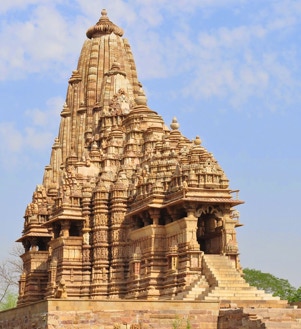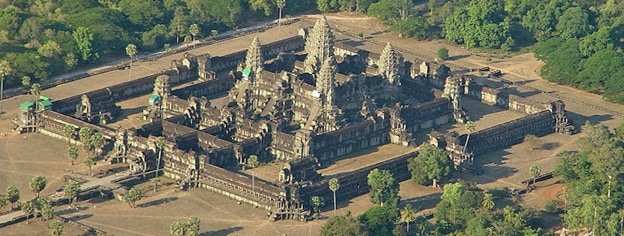PERSPECTIVES ON THE KHMER
“TEMPLE MOUNTAIN”
An Introduction
The profiles of the two temples juxtaposed in figure 1 (above) are among the most familiar in all of architecture and often cited as the finest and most representative achievements of their respective traditions. They date from within a century of each other and are each dedicated to one of the Hindu Trimurti, Shiva and Vishnu. They share a common ancestor in the first free-standing, stone Indian temples, such as those at Deogarh, Aihole and Mamallapuram themselves derived from earlier simple daub and wattle roadside shrines. Finally, both were designed as “temple mountains” symbolizing Mt. Meru, home of the Vedic pantheon, from where its prolific deities could descend and bless their devotees. Therefore, one perspective from which to view this survey of forty Khmer and related “temple mountains” might be to ask the easily over-looked question how and why this nearly universal cosmological icon, the “temple mountain,” was interpreted so differently at Angkor, Khajuraho, Pattadakal, My Son, Bagan, Ayutthaya, for that matter, Saqqara, Chichen Itza and even the Bayon?
Angkor - from Diverse Angles
Templemountains.org is intended as a resource for its users to answer this and similar questions for themselves by tracing the evolution of the Khmer “temple mountain” over five centuries and across multiple dimensions. It introduces the basic vocabulary and grammar of an ancient, though unfamiliar, “architectural language,” a tradition in which the genesis of a temple and the universe are inextricably linked. Its fourteen introductory essays offer users a spectrum of perspectives – aesthetic, archaeological and philosophical – for a “closer reading” of Khmer and related monuments, whether on a visit to Southeast Asia or on their laptops. Each thematic strand is illustrated by a paradigmatic “temple mountain” from Ak Yom to Angkor Wat and Borobudur to Kandariya Mahadeva. Topics include: mandalas as design templates; aedicules or replicas of shrines, as basic building blocks; their axial and lateral projection to give temples spatial extension; symmetry and asymmetry, ratios and remainders, as markers of the passage from the profane to the sacred.
The core of the site is its robust Catalog of Forty Khmer Temples dating from the 8th to 13th Centuries, with over 300 photographs, site plans and commentary on each monument’s distinctive features and place in the development of the “temple mountain” motif at Angkor. These are supplemented by ten Appendices or Background Notes on Hindu and Buddhist cosmology, theology and mythology, as well as maps, a Khmer time-line, teaching resources and users’ comments.
Finally, More Temple Mountains: A Survey, a growing anthology, already includes more than one hundred “temple mountains” beyond Angkor’s cultural ambit, documented in 600 extensively annotated photographs which place Khmer achievement in a global context. In the coming months, the present sites in Karnataka and Mesoamerican will be expanded and supplemented by temples from Myanmar, Thailand and Greece
Templemountains.org’s diverse resources enable users to explore in the buildings’ own terms the paradox implicit in their underlying architectural metaphor; how to build a “liturgical path” from the terrestrial to metaphysical plane with steps of brick and stone and represent a dimensionless or non-manifest absolute with the largest masses of masonry on earth?
A Rescourcebank
Templemountains.org is designed for independent learning so its users can chart their own exploration of the temple architecture of Angkor and beyond. The site’s 3GB of original resources are segmented into one hundred, concise “study modules” which can stand alone or be combined in any order. The text is color-coded throughout to differentiate major points and concepts from technical analysis and supplementary commentary; readers then decide the degree of detail they want. The tips in BEFORE YOU BEGIN… shows how with one click users can directly access the resource they seek.
Templemountains.org is not intended as a field guide to the monuments at Angkor; there are many serviceable ones already (a few listed here.) Nor does it presume to summarize, let alone contribute to the century and half of dedicated scholarship which has done so much to make Angkor’s monuments accessible to students and visitors. Instead, it is a resource for the more than casual tourist and less than professional researcher who seeks a deeper engagement with this unforgettable architecture than a Wikipedia entry or tour operator’s website.
This site was compiled by the Angkor and Beyond Resource Group, an informal collaboration of autodidacts lacking formal training as archaeologists, architects, Khmer specialists or, most conspicuously, photographers. It suffers from the errors, omissions, misplaced emphasis and malaprop technical vocabulary which inevitably result from an idiosyncratic and desultory acquaintance with the copious literature on Angkor. Perhaps the occasional insights gleaned from viewing familiar buildings from unorthodox points of view and the serendipitous speculations uninhibited by academic circumspection may, in small part, compensate for amateurs’ unavoidable blunders and blindness. The site will have achieved its modest goals if it stimulates its users to pursue the issues it merely grazes with the depth and diligence they deserve and repay.
A Note on Terminology
In the absence of a KhmerVastu Shastraor Vitruvius, Angkorian temples have usually been described in a macaronic pidgin scavenged from foreign architectural languages, principally Nagara (Northern Indian) and Dravida (Southern Indian) texts, as well as the more remote, but marginally more familiar, lexicon of Greek and Roman classicism. These terms at best approximate their Khmer counterparts, therefore, rather than select an inadequate substitute, this site deliberately employs similar terms from different traditions, often interchangeably, listing alternatives whenever practical, to stress that they are analogous note quivalent e.g.,jagati, upapitha, stereobate, pteron, plinth, base.
This imprecision in terminology is matched by orthographic inconsistencies resulting from shifting systems of transliteration. The IPA would only be obscurantist for the intended users of this site, while the most widely recognized spellings are often not the most current or accurate. Therefore eclecticism again has seemed the least bad option e.g., shikhara but sekhari, Preah Vihear but Prei Enkosei, Somesvara, Someshvara, Someswara, Someshwara or Somesvar. Transliterations have been placed in italics both to signify their problematic status and draw attention to their origins. This convention does not, of course, extend to proper names and words which have entered English such as bodhisattva and mandala.
Apology in Place of an Acknowledgement
The acknowledgement is a justly neglected genre noted solely for the audacity of its insincerity; its mauvaise foi resides not in it obsequiousness but in disguising its debts as sycophancy. The following therefore is not an acknowledgement or apologia but apology.
Dilettantes need not apologize for their enthusiasm; it is what separates them from academic sobriety. They should, however, exonerate those whose serious scholarship they have trivialized for their idle amusement. The improbable inspiration for this website on Angkor’s monuments was Prof. Adam Hardy’s path-breaking studies of “aedicular expansion” as the generative grammar of the Karnata Dravida “language” of Indian temple architecture. To a naïve and none-too-diligent reader it begged the question how the Khmer’s closest equivalent to an aedicule, a single-cell prasat, which scarcely changed across their history, could expand to such enormous proportions? This misguided attempt to apply Prof. Hardy’s rigorous methodology to the incommensurable Khmer tradition unavoidably turned an intended tribute into a travesty. The site’s ramshackle logic irrefutably proves its impertinent and surreptitious construction without Prof. Hardy’s imprimatur, input, permission or doubtless indignant protest. He is il miglior fabbro, it so sorely lacks.
Templemountains.org would not exist were it not for the unswerving perseverance and forbearance of Pacific Print Media (pacprint.com) and its committed creative staff. When they first donated their decades of design experience to this quixotic project, it seemed it might take at most a month to finish. Yet for over a year, they accommodated its endless expansions and revisions with unflagging grace and élan. Their pages make only too clear how unworthy their desultory content is of its graphic context. It is, therefore, with a gratitude too profound to express except by their own accomplishment, that this site is dedicated to:
Pacific Print Media
si requiris suam memoriam circumspicite

Suggested Guidebooks and Introductions:
Booth, Andrew, The Angkor Guidebook:
Your Essential Companion to the Temples
(ABOUTAsia Travel, Siem Reap, 3rd edition, 2016)
Chanchani, Nachiket, Mountain Temples & Temple Mountains: Architecture, Religion and Nature in the Central Himalayas (University of Washington Press, Seattle, 2019)
Freeman, Michael and Jacques, Claude, Ancient Angkor (River Books, Bangkok, revised 2003)
Hardy, Adam, Indian Temple Architecture – Form & Transformation: the Karnata Dravida Tradition, 7th
to 13th Centuries (Abhinav Publications, New Delhi, 1995)
Hardy, Adam, The Temple Architecture of India (Wiley, Hoboken, 2008)
Jessup, Helen Ibbitson,
Art and Architecture of Cambodia
(Thames and Hudson, London, 2004)
Laur, Jean, Angkor:
An Illustrated Guide to the Monuments
(Flammarion, Paris, 2002)
Rooney, Dawn, Angkor:
Cambodia’s Wondrous Khmer Temples
(Odyssey, Hong Kong, 2006)
Roveda, Vittorio,
Khmer Mythology:
Secrets of Angkor Wat
(Weatherhill, New York, 1998)

FIGURE 1: KANDARIYA MAHADEVA , KHAJURAHO, INDIA (c.1030)
LEFT (above) : ANGKOR WAT, SIEM REAP, CAMBODIA (1113 - 1150) RIGHT.
